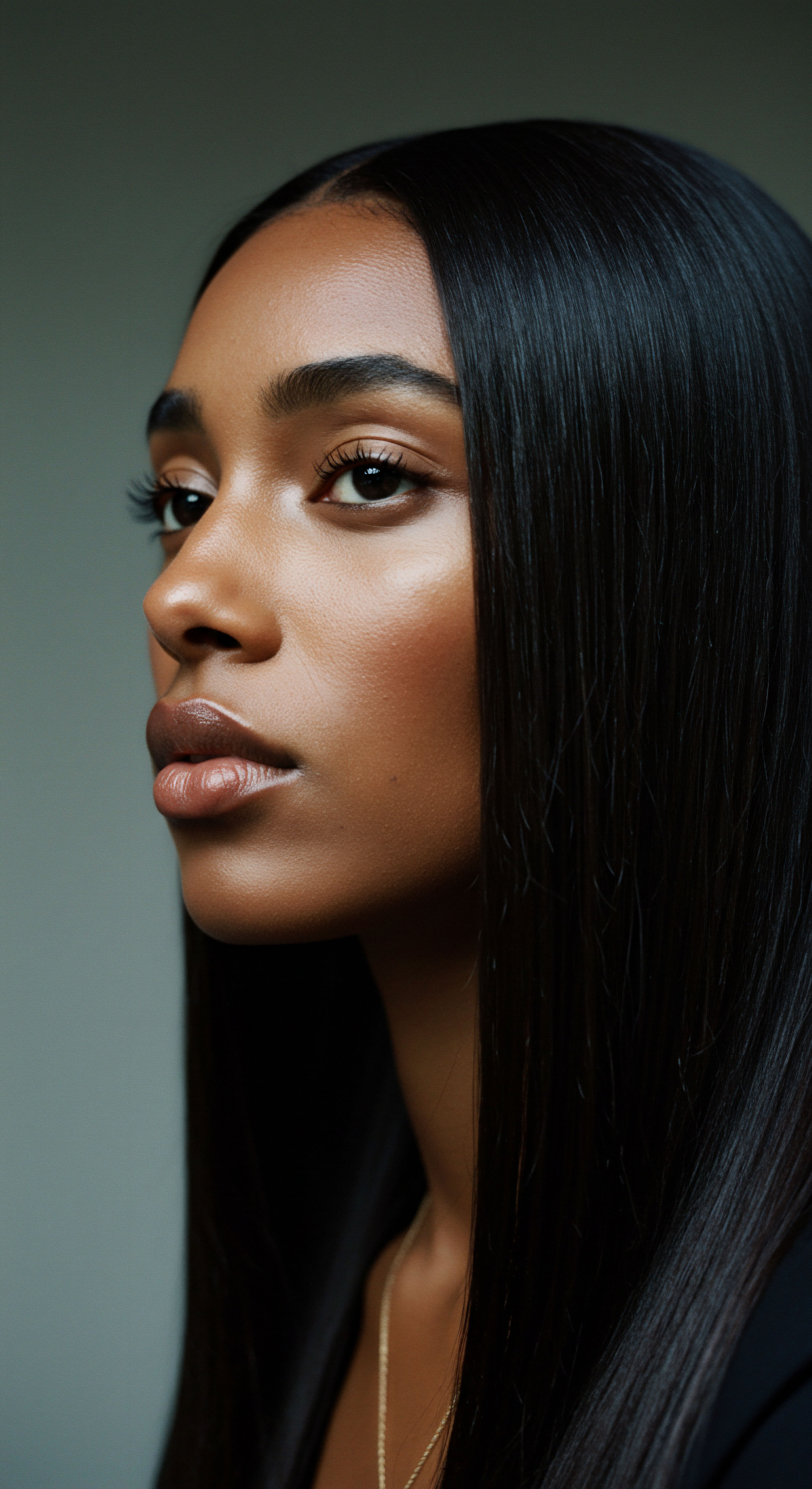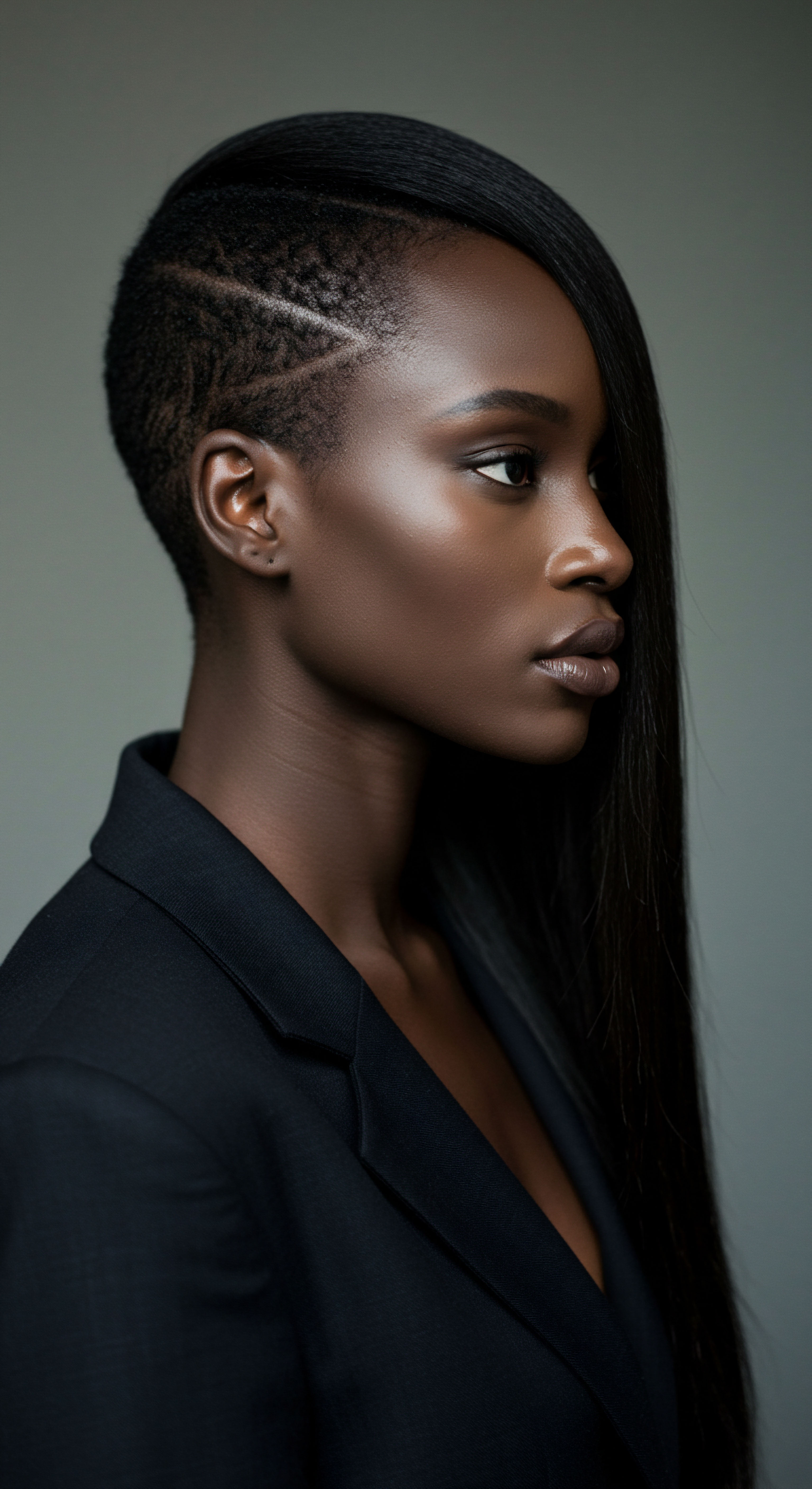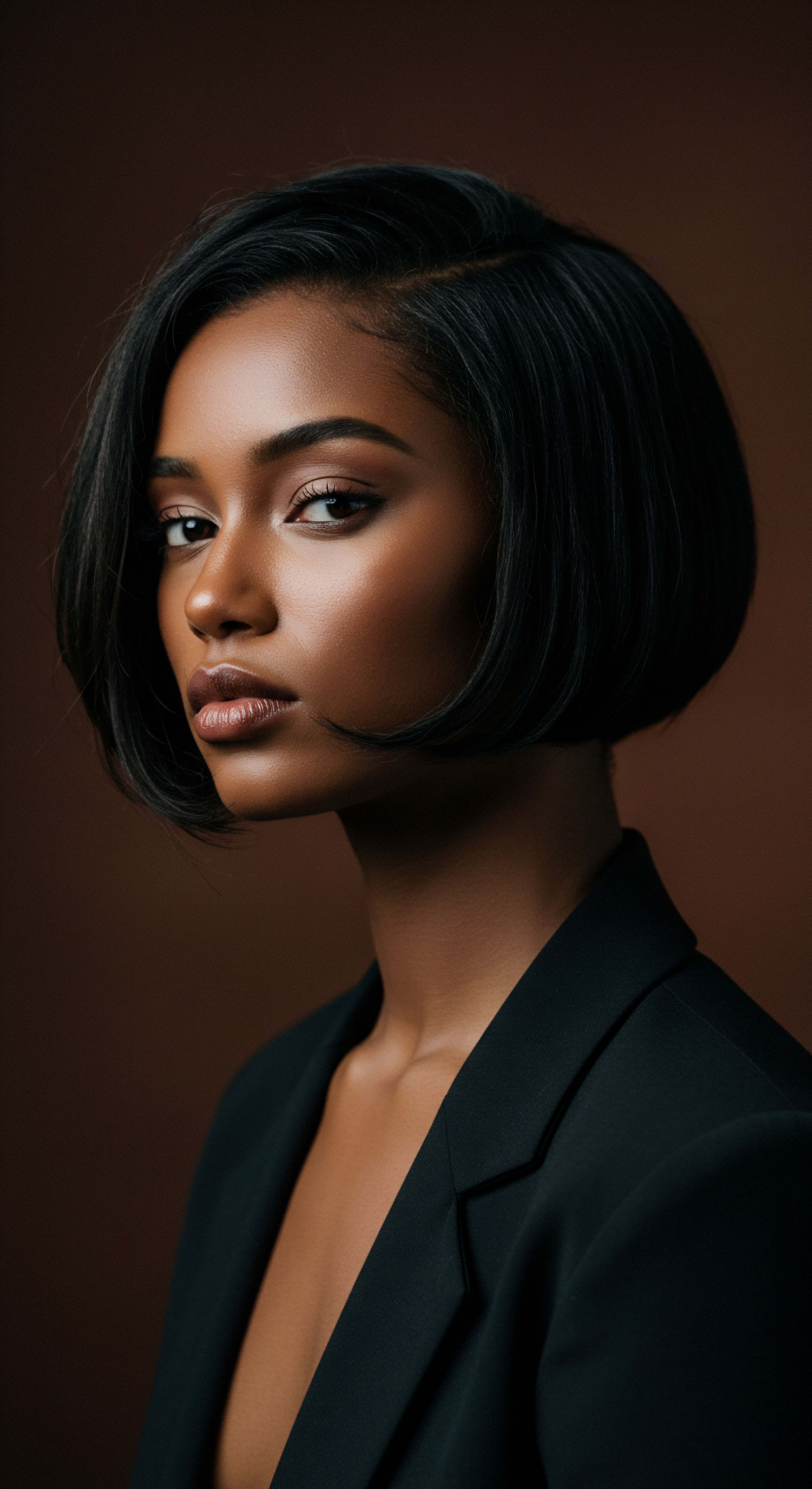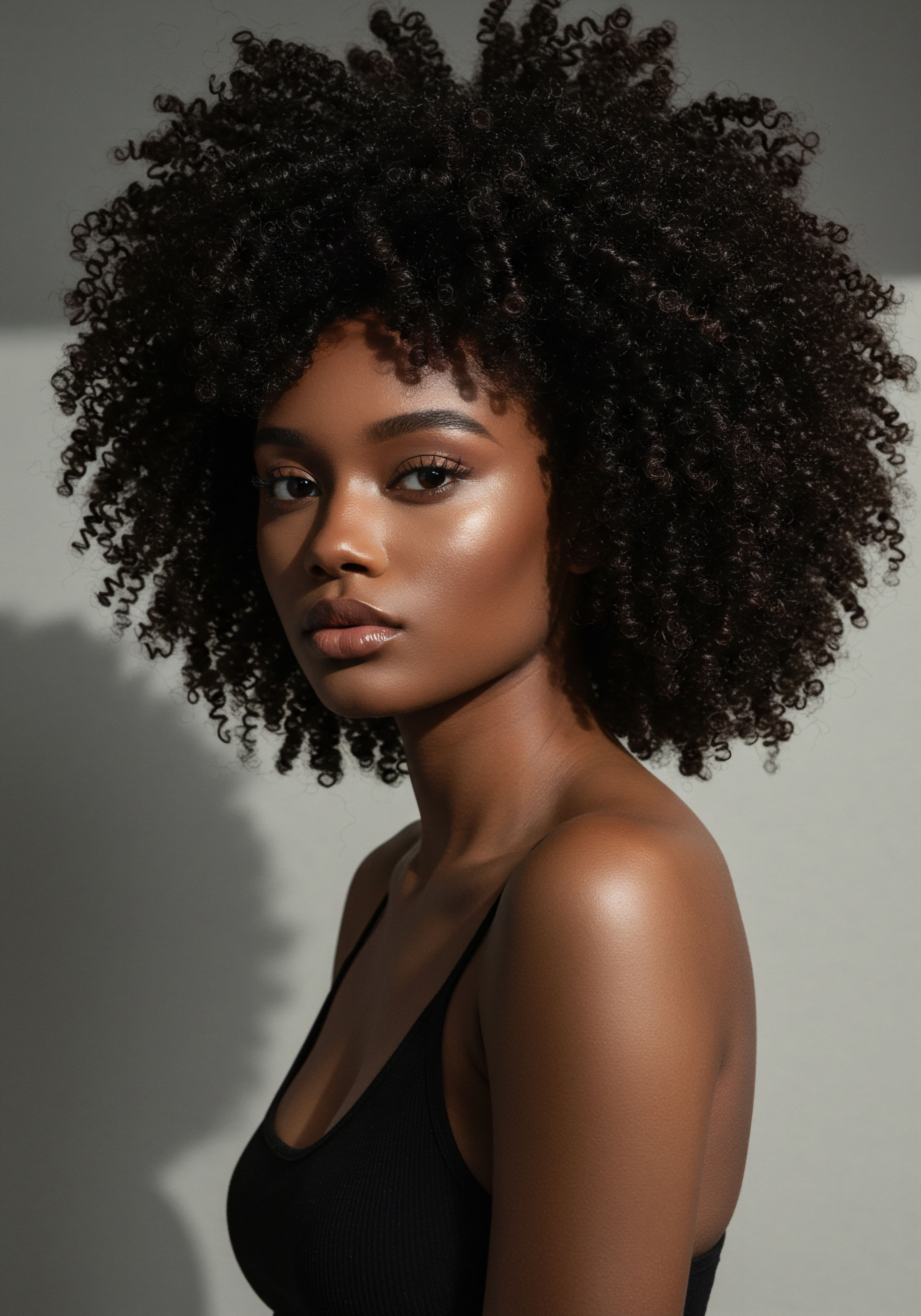
Roots
The very notion of hair health often begins with a quiet question ❉ what truly makes our strands vibrant, soft, and supple? Beyond the surface sheen, beyond the temporary feel of products, lies a deeper truth rooted in the very architecture of each individual hair. We speak of moisture, a living quality for our hair, yet its presence or absence is largely dictated by an unseen guardian ❉ the hair cuticle. This outermost layer, a delicate shield, holds the secret to whether water dances freely within the hair fiber or evaporates into the air, leaving dryness in its wake.
Consider the microscopic landscape of a single hair strand. It is a wonder of biological engineering, composed of three primary layers. The innermost portion, the medulla, sometimes absent in finer hair types, plays a lesser role in moisture dynamics. Surrounding it rests the cortex, a robust central body responsible for hair’s strength, elasticity, and its inherent color.
This cortex holds the majority of the hair’s water content. Protecting these inner structures, like overlapping roof shingles on a miniature dwelling, lies the cuticle.

The Cuticle’s Silent Watch
The cuticle consists of dead, flattened cells, typically between six and ten layers deep, arranged in a precise, imbricate pattern. These cells contain keratin proteins and a specialized lipid layer, particularly rich in 18-methyleicosanoic acid (18-MEA), on their outer surface. This external lipid coating grants the hair its natural water-repelling property, a characteristic known as hydrophobicity.
When this protective layer is intact and smooth, the cuticle scales lie flat, reflecting light and creating that desirable sheen we associate with healthy hair. More significantly, this smooth, tightly closed arrangement acts as a vigilant gatekeeper, regulating the flow of water into and out of the hair shaft.
The hair cuticle, a layered shield of dead cells, serves as the primary regulator of moisture within each strand.
A hair with an uncompromised cuticle resists excessive water absorption from humid surroundings and simultaneously slows the rate at which internal moisture escapes into drier air. This balanced exchange is fundamental for maintaining hair’s suppleness, flexibility, and overall well-being. When the cuticle is sound, the hair retains its natural hydration, appearing plump and resilient.

What Happens When the Cuticle’s Defense Weakens?
When the cuticle’s integrity is compromised, the scales lift, become jagged, or even chip away. This disruption transforms the hair’s surface from a smooth, protective barrier into a rough, porous landscape. The consequences for moisture are immediate and pronounced. Water, previously held at bay or carefully managed, now enters and exits the hair shaft with far less regulation.
The increased porosity means hair readily absorbs water from the environment, often leading to swelling and frizz in humid conditions. However, this same openness means moisture is lost just as quickly when the air is dry, leaving the hair feeling parched, brittle, and rough to the touch. This constant fluctuation, the swelling and shrinking of the hair shaft, places immense stress on its internal structure, leading to diminished elasticity and heightened susceptibility to breakage.
The degradation of the external lipid layer, particularly the 18-MEA, further exacerbates this issue. This lipid layer is vital for hair’s hydrophobicity. When it is diminished, the hair becomes more hydrophilic, or water-loving, accelerating both the absorption and subsequent loss of water.
- Cuticle Scales ❉ Overlapping cells that form the outermost protective layer of the hair.
- Hydrophobicity ❉ The property of hair to repel water, largely maintained by the cuticle’s lipid layer.
- Porosity ❉ The hair’s ability to absorb and retain moisture, directly influenced by cuticle integrity.
The journey to understanding hair moisture begins with appreciating the humble yet mighty cuticle. Its condition dictates much of what we experience daily with our hair, from its visual appeal to its tactile quality and its ability to withstand environmental shifts.

Ritual
Our daily interactions with hair, from cleansing to styling, are more than mere routines; they are rituals that profoundly influence the cuticle’s well-being and, by extension, the hair’s ability to retain vital moisture. These repeated actions, seemingly small, collectively sculpt the very surface of our strands, determining whether they remain a sealed sanctuary for hydration or become an open invitation for dryness. The careful selection of products and the mindful application of techniques become acts of care, safeguarding the delicate external layers of our hair.

Daily Practices and Cuticle Well-Being
The cleansing process, for instance, can be a double-edged sword. While removing impurities and product buildup, harsh cleansers containing sulfates can strip away the hair’s natural oils, including the protective lipids on the cuticle surface. This removal leaves the cuticle exposed and vulnerable, its scales more prone to lifting.
When the lipid barrier is compromised, hair becomes more hydrophilic, allowing water to enter and leave with less resistance. This leads to increased porosity, making hair feel rough and prone to tangling.
Similarly, the application of heat without proper protection is a significant factor in cuticle degradation. High temperatures from blow dryers, flat irons, and curling wands can cause the water within the hair shaft to boil, creating internal pressure that lifts and damages the cuticle scales. This thermal stress denatures the keratin proteins within the cuticle, leading to a permanent disruption of its smooth structure and a rapid loss of internal moisture.
Thoughtful hair rituals, from gentle cleansing to protective styling, are fundamental in preserving cuticle integrity and moisture balance.
Mechanical manipulation, such as vigorous brushing or combing, particularly on wet hair, also exerts considerable force on the cuticle. Wet hair is more susceptible to stretching and damage. When brushes or combs encounter tangles, the friction and tension can literally chip away at the delicate cuticle scales, causing them to fray and lift. Tight hairstyles, even when worn for extended periods, contribute to this mechanical stress, leading to localized cuticle damage and subsequent moisture loss.
| Practice Harsh Cleansing |
| Effect on Cuticle Removes protective lipids, lifts scales |
| Moisture Outcome Increased porosity, rapid moisture loss |
| Practice Heat Styling Without Protection |
| Effect on Cuticle Denatures keratin, lifts scales |
| Moisture Outcome Dryness, brittleness, diminished hydration |
| Practice Vigorous Brushing |
| Effect on Cuticle Mechanical abrasion, fraying of scales |
| Moisture Outcome Rough texture, susceptibility to dryness |
| Practice Chemical Treatments |
| Effect on Cuticle Breaks bonds, lifts scales |
| Moisture Outcome High porosity, difficulty retaining water |
| Practice Understanding these impacts allows for more mindful hair care choices. |

How Can We Guard the Cuticle’s Moisture Gate?
The path to maintaining cuticle integrity and moisture involves a shift towards more gentle, informed practices.
- Cleansing Mindfully ❉ Opt for sulfate-free, moisturizing shampoos that cleanse without stripping natural oils. Focus on cleansing the scalp and allowing the lather to gently rinse through the lengths.
- Conditioning Generously ❉ Conditioners, especially those with humectants and emollients, help to smooth down lifted cuticle scales, providing a temporary seal that aids in moisture retention. Leave-in conditioners extend this protective effect.
- Protecting from Heat ❉ Always apply a heat protectant before using styling tools. These products create a barrier that minimizes thermal damage to the cuticle, preserving its structure.
- Detangling with Care ❉ Use a wide-tooth comb or your fingers to gently detangle hair, starting from the ends and working upwards. Consider detangling on damp hair with a slippery conditioner to reduce friction.
These practices, when consistently applied, create a protective ritual that helps the cuticle remain a resilient guardian of moisture, allowing hair to retain its natural softness and resilience against the rigors of daily life.

Relay
Beyond the immediate effects of daily practices, a deeper conversation reveals how the integrity of our hair’s outer layer, the cuticle, is intertwined with broader influences, including ancestral heritage, environmental factors, and even the subtle interplay of lipids. This conversation invites us to look past surface observations and consider the intricate, often unseen, forces that dictate our hair’s moisture experience. What scientific observations reveal about hair’s unique response to its environment provides a lens for truly understanding its moisture needs.

What Distinguishes Hair Cuticles Across Ancestries?
The human hair shaft, while universally composed of a cuticle, cortex, and medulla, exhibits structural variations across different ancestries that profoundly impact moisture dynamics. Research has shown distinct differences in cuticle layers and lipid composition, which influence how hair interacts with water and responds to external stressors. For instance, African hair, with its unique helical structure, can possess fewer cuticle layers on its major axis (as few as 1 or 2, compared to 6 to 8 on the minor axis). This anatomical characteristic, combined with a lower order of lipids within its cuticle, contributes to increased permeability.
This increased permeability means African hair can absorb water more readily, which might seem beneficial, yet it also loses moisture at a faster rate, contributing to dryness and a perception of high porosity. A study published in ‘Skin Research and Technology’ (2020) demonstrated that while African hair cuticle exhibited more lipids, these lipids possessed a lower ordered bilayer compared to Caucasian hair, which had more ordered lipids, and Asian hair, which showed a very low level of lipids on the cuticle region. The same study concluded that African hair displayed increased permeability, while Asian hair appeared more resistant to hydration changes. This less ordered lipid arrangement in African hair suggests a less efficient barrier against moisture loss, even with a higher lipid content.
This contrasts with Asian hair, often characterized by a greater number of compact cuticle layers and higher overall cuticle thickness, lending it superior mechanical properties and resistance to hydration changes. Caucasian hair, positioned between these two, often shows a higher water absorption capability in humid conditions but a slower diffusion rate.
Ancestral variations in cuticle layers and lipid arrangement significantly alter hair’s moisture interaction and environmental resilience.
This scientific insight provides a foundation for understanding why textured hair, particularly coily and curly types often associated with African ancestry, can feel perpetually dry and requires specific, consistent hydration strategies. The challenge extends beyond simply adding water; it encompasses creating an environment that encourages water retention.

How Does Environmental Humidity Shape Hair’s Moisture Content?
The air around us, with its fluctuating humidity, exerts a constant influence on hair’s moisture content, mediated directly by the cuticle. In high humidity, the hair cuticle can lift, allowing water molecules from the air to penetrate the hair shaft. This absorption causes the hair to swell and can disrupt the internal hydrogen bonds, leading to frizz and a change in hair texture. Conversely, in dry conditions, hair rapidly loses its internal moisture to the environment, resulting in brittle, dull strands.
The concept of Hygral Fatigue arises from this dynamic. This condition refers to the damage caused by the repeated swelling and shrinking of the hair shaft as it absorbs and releases water. Hair with a compromised cuticle is particularly susceptible, as the protective barrier is less effective at regulating this moisture exchange. This constant flux weakens the hair fiber, leading to breakage and a further decline in its ability to hold moisture.
- 18-MEA ❉ A lipid covalently bound to the cuticle surface, crucial for hair’s water repellency.
- Permeability ❉ The ease with which substances, including water, can pass through the hair’s outer layer.
- Hygral Fatigue ❉ Damage resulting from the repeated absorption and loss of water by the hair.
The hydrolipidic film, a thin layer of sebum and sweat covering the scalp and hair, also plays a critical role in cuticle health and moisture preservation. When this film is balanced, it acts as a natural seal, helping to retain water within the hair fiber and protecting against external aggressors. An insufficient hydrolipidic film, often due to reduced sebum production or harsh product use, leaves the cuticle vulnerable, exacerbating dryness and moisture loss.
Understanding these intricate relationships, from ancestral cuticle characteristics to the daily dance with humidity and the vital role of lipids, provides a comprehensive view of how hair cuticle integrity directly impacts moisture. It guides us toward a more informed and respectful approach to textured hair care, one that acknowledges its inherent structure and environmental responses.

Reflection
Our exploration into the hair cuticle’s role in moisture retention has revealed a profound connection between the microscopic world of hair structure and our lived experience of hair health. It becomes evident that caring for our strands transcends mere aesthetics; it is an act of acknowledging the intricate biological design that governs their well-being. Each choice, from the water we use to the products we apply and the tools we employ, either reinforces or challenges the cuticle’s delicate balance.
This deeper appreciation invites us to approach our hair with thoughtful intention, understanding that its ability to hold onto its life-giving hydration rests firmly on the integrity of its outermost shield. When we tend to this unseen guardian with care, we allow our hair to truly flourish, reflecting its inner vitality outward.

References
- Robbins, C. R. (2012). Chemical and Physical Behavior of Human Hair (5th ed.). Springer.
- Garg, S. & Sharma, V. (2018). Hair ❉ Its Structure, Functions, and Disorders. In Textbook of Clinical Dermatology (pp. 1-14). Jaypee Brothers Medical Publishers.
- Trueb, R. M. (2016). The Difficult Hair ❉ Challenges in Diagnosis and Management. Karger.
- Dawber, R. P. R. & Van Neste, D. (2004). Hair ❉ Physical Properties, Structure, and Growth. CRC Press.
- Marti, M. et al. (2020). Ethnic hair ❉ Thermoanalytical and spectroscopic differences. Skin Research and Technology, 26(4), 540-547.
- Schueller, R. & Romanowski, P. (2017). Conditioning Agents for Hair and Skin. CRC Press.
- Feughelman, M. (1997). Mechanical Properties of Keratin Fibers. Journal of the Society of Cosmetic Chemists, 48(2), 79-92.
- Bouillon, C. & Wilkinson, J. B. (2005). The Science of Hair Care. CRC Press.
- Gavazzoni Dias, M. F. R. (2015). Hair Cosmetics ❉ An Overview. International Journal of Trichology, 7(1), 2-15.
- Madan, S. (2018). Hair and Hair Care. Nova Science Publishers.